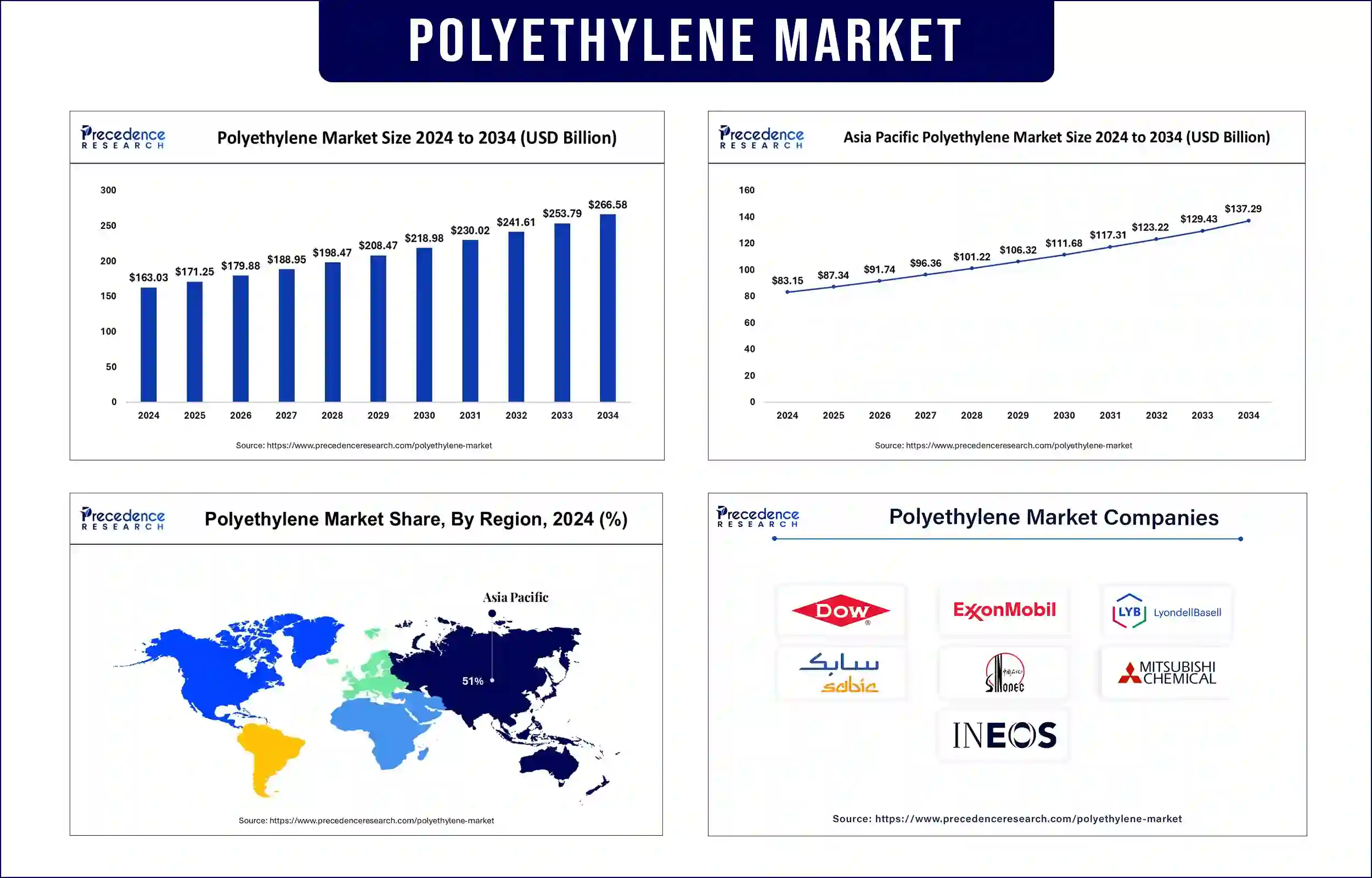December 2024
The global polyethylene market revenue reached USD 171.25 billion in 2025 and is predicted to attain around USD 253.79 billion by 2033 with a CAGR of 5.04%. The global market is witnessing steady growth, driven by rising demand across packaging, automotive, construction, and healthcare industries.

The polyethylene market spans a broad range of applications, from flexible films and rigid containers to pipes, wires, and medical-grade plastics. Rising consumer preference for lightweight, impact-resistant, and eco-friendly materials is driving innovation in polyethylene-based solutions. Polyethylene, a widely used thermoplastic, is valued for its versatility, durability, and recyclability. Key product categories include high-density polyethylene (HDPE), low-density polyethylene (LDPE), and linear low-density polyethylene (LLDPE), each serving distinct applications.
Polyethylene serves medical applications, as it remains inert while being durable, which allows use in medical tubing and also enables implant and prosthetics design. The application of polyethylene in disposable medical products proves essential for stopping disease spread and gained importance during the global COVID-19 crisis. Multiple governments across the world have established new plastic pollution control regulations to reduce waste. Despite its elevated reported recycling rates, South Korea experiences obstacles with plastic waste management, which suggests a requirement for better waste solutions. The polyethylene market is shaped by sustainable practices together with regulatory measures, which serve as essential components for its future development.
Growing Demand for Sustainable Polyethylene
Manufacturers generate biodegradable and recyclable polyethylene solutions as governments, together with regulatory bodies, have strengthened regulations on single-use plastics. The European Union’s Circular Economy Action Plan joins several worldwide regulations in pushing all industries to adopt eco-friendly production practices. The United Nations Environment Programme (UNEP) underlined the necessity for fast plastic waste reduction across the world in 2023 by advocating for better recycling performance and different materials.
Leading chemical corporations now dedicate investments to developing bio-based polyethylene production through renewable feedstock sugarcane extraction to decrease their reliance on fossil fuels. The nations of Japan and South Korea lead the field in developing chemical recycling methods that transform polyethylene waste into reusable starting materials. The rising market demand for environmentally friendly packaging encourages retailers and FMCG brands to increase their usage of recycled polyethylene in their products.
Advancements in Bio-Based Polyethylene Production
Major corporations in the polyethylene market spend money on bio-polyethylene produced from renewable raw materials, including sugarcane and corn starch, to eliminate fossil fuel dependence while preserving the performance characteristics of regular polyethylene. The global capacity for bio-based polymers, particularly polyethylene, experienced substantial growth as continuous development in biobased and biodegradable polymers. Better fermentation processes and polymerization techniques increase the production capacity and quality standards for bio-based polyethylene.
The use of bio-based polyethylene received a boost from effective advances in enzymatic conversion and other bioprocessing systems. The sustainable innovations contribute to worldwide sustainability objectives through their provision of eco-friendly plastic replacements.
Increasing Adoption in Automotive and Construction Sectors
Polyethylene's lightweight and high-impact resistance properties are fuelling its adoption in automotive components, insulation materials, and construction films. The demand for energy-efficient, cost-effective, and recyclable materials is boosting polyethylene applications in these industries.
New guidelines from the European Commission about sustainable materials in construction drive polyethylene adoption through the adoption of eco-constructed solutions. The United Nations Environment Programme (UNEP) confirmed through reports that building material applications of reusable plastics generate minimal carbon impact while engineers adopt polyethylene-based solutions.
Expansion of Plastic Recycling Technologies
The investment of governments alongside private sector entities proceeds into refined polyethylene recycling technologies through chemical procedures and mechanical procedures to boost sustainability performance. The established initiatives serve dual purposes by decreasing plastic waste and building up a circular economic system. The development demonstrates enhanced interaction between regulatory authorities alongside industry executives toward establishing a sustainable plastic recycling system that operates efficiently.
Asia Pacific is expected to maintain strong demand for the polyethylene market, fueled by expanding industrial sectors, infrastructure development, and government-led sustainability initiatives. Countries, including China, India, and Japan, are strengthening their plastic recycling capabilities and investing in advanced polyethylene production technologies. The Intergovernmental Negotiating Committee on Plastic Pollution held its first meeting in 2024 to develop an international, legally binding instrument, with Asia Pacific nations actively participating due to their shared commitment to addressing plastic pollution issues worldwide.
North America is projected to experience the fastest growth in the polyethylene market, supported by technological advancements in polymer science, increasing plastic recycling initiatives, and growth in sustainable packaging applications. The advancement of polyethylene versions using high-performance materials through technological advancements allows their use in diverse industrial applications.
The automotive industry started using lightweight materials to boost fuel efficiency, which has made automobiles rely heavily on polyethylene components during production. The industry demonstrates its dedication to plastic waste reduction through implementation initiatives that support circular economic practices. These programs, together with collected data, show that North America is intensifying its focus on making polyethylene production and use more sustainable while participating in worldwide efforts to battle plastic waste and establish recycling cycles.
| Report Attribute | Key Statistics |
| Market Revenue in 2025 | USD 171.25 Billion |
| Market Revenue by 2033 | USD 253.79 Billion |
| CAGR | 5.04% |
| Quantitative Units | Revenue in USD million/billion, Volume in units |
| Largest Market | North America |
| Base Year | 2024 |
| Regions Covered | North America, Europe, Asia-Pacific, Latin America, and Middle East & Africa |
By Type
By Application
Get this report to explore global market size, share, CAGR, and trends, featuring detailed segmental analysis and an insightful competitive landscape overview @ https://www.precedenceresearch.com/sample/1440
You can place an order or ask any questions, please feel free to contact at sales@precedenceresearch.com| +1 804 441 9344
December 2024
January 2025
April 2025
January 2025